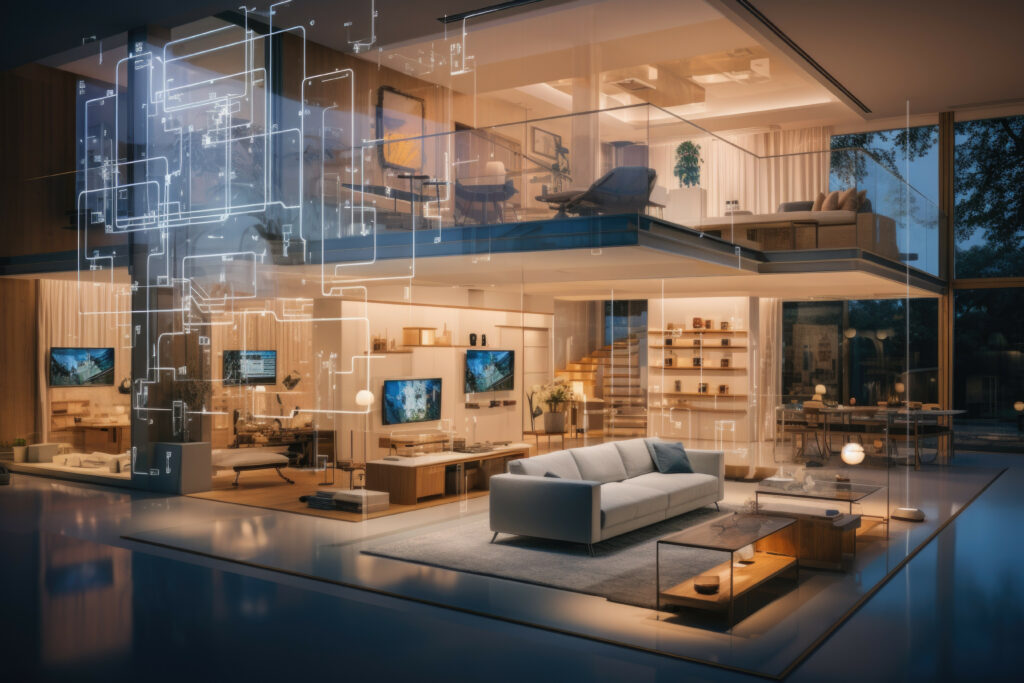
Designer: Suzanne Rheinstein; more details below.
By Carl J. Dellatore

You would be hard-pressed to open a newspaper or to visit an online media outlet without discovering an article about the coming (or already here?) artificial intelligence revolution. Some praise AI’s problem-solving virtues in medical treatment and data analysis; others warn of impending calamity as malicious actors misuse AI to disrupt communication or further dilute any semblance of privacy we still have.
Consider this: In November 2023, there were no less than 40 stories on AI in the New York Times–covering everything from AI-controlled drones deployed in warzones to AI’s impact on career illustrators whose livelihoods are now threatened by art-generation programs. That latter example brings the point closer to home as we ponder how artificial intelligence affects architecture and design professionals.
On architecture: An August 2023 piece published in the Guardian, written by Oliver Wainwright and titled “It’s Already Way Beyond What Humans Can Do: Will AI Wipe Out Architects?” takes an in-depth look and the conclusions–some fancied and others already realized–are no less than earth-shaking. AI is altering the future of architecture in unimaginable and revolutionary ways.
As a designer, you may already use Generative AI to create 3D models, optimize space planning, or organize floorplans. Machine Learning is taking hold, too, with programs that analyze preferences and predict what furniture your client might choose in a given room. And Financial Anaylsis programs are quickly advancing, helping designers improve accuracy, transparency, and workflow–all towards maximizing profit margins. Taken together, these advances are changing designer’s lives for the better.

But the questions persist: Will artificial intelligence take over the interior design industry? Or worse, render it obsolete?
The answers, at least in part, can be found in a piece the late designer Suzanne Rheinstein wrote in my book Interior Design Master Class on the subject of Nuance. Contemplate her paragraph on the elements of a room;
“Assuming the architecture has been attended to, and the preliminary floor plans made, choosing the furniture must be done carefully. When considering pieces old and new, pay attention to finish and textures. The antique chairs I buy often have beautiful old and rubbed (not chipped!) paint with the wood showing through or faded gilt or mellow fruitwood frames, which look very attractive in the same room, with none of them standing out more than another. The tables may be small shapes from Asia, with forty applied coats of lacquer creating the characteristic soft undulations in the surface. Or it can be a bespoke modern table with a smooth lacquer finish and simple bronze legs. I sometimes order extremely plain tables or desks with very finely woven raffia or glazed linen applied for texture.”

Rheinstein’s operative words are somewhat alliterative–choosing, carefully, and considering–but they make an essential point: The devil is in the proverbial details. The nuanced decisions she made during her career elevated her rooms, for which she found herself on the AD 100 and Elle Decor’s A-List year after year. Her carefully honed aesthetic vision gives us insight into the future of design in the age of AI because while it may be true that a software program can choose color palettes or organize floorplans, it’s the nuanced details arrived at through years of experience working as a designer, that artificial intelligence misses–at least for now.
I’ve been thinking not about how AI advancements could detrimentally impact the design industry–but how the changes might make for better designers.
Hear me out.
While it may be an oversimplification, designers create interiors by identifying aspirations, exerting creativity, and marshaling resources to realize individually tailored spaces for their clients. That statement offers a roadmap.
Thinking about aspiration, the late Steve Jobs had it right: Don’t give the people what they want; give them what they don’t know they want yet. Have in-depth conversations with your clients that help you arrive at design solutions beyond your client’s expectations. Regarding creativity, challenge yourself to find furnishings and finishes that set you apart; instead of a showroom piece, scour the local antique shops for something unusual or engage an artisan to make a one-of-a-kind piece. And go the extra mile on installation day–stock the new refrigerator with your client’s favorite champagne or have fresh peonies on the dressing table. Together, these actions will underscore the value of hiring a design professional.
Designers who balance the advantageous aspects of machine learning with an ever-expanding use of their imaginations will continue to succeed far into the future. I’d bet on it.

Stay updated on this series author, Carl Dellatore, by following his Instagram. About Carl Dellatore & Associates – provides designers, architects, and creatives with writing, editing, and copyediting services by an established team to effectively reveal your story.


